Henry Dundas, 1st Viscount Melville
Henry Dundas, 1st Viscount Melville, PC, FRSE (28 April 1742 – 28 May 1811) was a Scottish advocate and "independent Whig" politician. He was the trusted lieutenant of British prime minister William Pitt, and the most powerful politician in Scotland in the latter decades of the 18th century.
The Viscount Melville | |
|---|---|
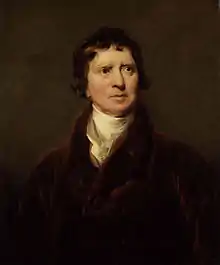 Henry Dundas, 1st Viscount Melville by Sir Thomas Lawrence | |
| First Lord of the Admiralty | |
| In office May 1804 – May 1805 | |
| Monarch | George III |
| Prime Minister | William Pitt the Younger |
| Preceded by | The Earl of St. Vincent |
| Succeeded by | The Lord Barham |
| Secretary of State for War | |
| In office July 1794 – March 1801 | |
| Monarch | George III |
| Prime Minister | William Pitt |
| Preceded by | New Office |
| Succeeded by | Lord Hobart |
| President of the Board of Control | |
| In office June 1793 – May 1801 | |
| Monarch | George III |
| Prime Minister |
|
| Preceded by | The Lord Grenville |
| Succeeded by | Viscount Lewisham |
| Home Secretary | |
| In office 8 June 1791 – 11 July 1794 | |
| Monarch | George III |
| Prime Minister | Pitt |
| Preceded by | The Lord Grenville |
| Succeeded by | The Duke of Portland |
| Lord Advocate | |
| In office 24 May 1775[1] – August 1783 | |
| Monarch | George III |
| Prime Minister | |
| Preceded by | Sir James Montgomery |
| Succeeded by | Henry Erskine |
| Member of Parliament for Edinburgh | |
| In office 1790–1802 | |
| Preceded by | Sir Adam Fergusson |
| Succeeded by | Charles Hope |
| Personal details | |
| Born | 28 April 1742 Edinburgh, Scotland |
| Died | 28 May 1811 (aged 69) Edinburgh, Scotland |
| Nationality | Scottish British |
| Political party | "independent Whig" |
| Spouse(s) |
|
| Children | Robert Dundas, 2nd Viscount Melville |
| Alma mater | University of Edinburgh |
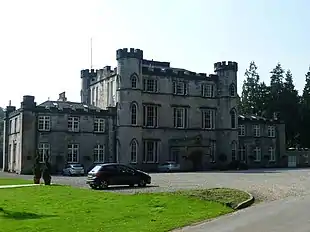
Henry Dundas was instrumental in the encouragement of the Scottish Enlightenment,[2] in the prosecution of the war against France, and in the expansion of British influence in India. He spearheaded a vain attempt to capture the French colony of Saint-Domingue during the antislavery Haitian Revolution. His deft and almost total control of Scottish politics during a long period when no monarch visited the country, led to him being nicknamed King Harry the Ninth, the "Grand Manager of Scotland" (a play on the masonic office of Grand Master of Scotland), the "Great Tyrant" and "The Uncrowned King of Scotland".[3]
He is commemorated by one of the most prominent memorials in Edinburgh, the 150-foot high, Category A listed Melville Monument at St Andrew Square, in the heart of the New Town he helped to establish. The monument was paid for mostly by friends and Naval personnel. The statue is controversial because of the role Dundas allegedly played in delaying the abolition of the slave trade in 1792 and 1796. There were demonstrations against the statue during the Black Lives Matter protests in June 2020.[4] In June 2020, the Edinburgh City Council voted to install a new plaque on the Melville Monument acknowledging Dundas’ role in deferring the abolition of the slave trade.[5][6]
Background and education
Dundas was born in Edinburgh on 28 April 1742 in the house known as 'Bishop's Land' (a former lodging of the Archbishop of St. Andrews) on the Royal Mile. He was the fourth son of Robert Dundas of Arniston, Lord President of the Court of Session, by his second wife, Anne Gordon, daughter of Sir William Gordon of Invergordon. He first attended Dalkeith Grammar School before an attack of smallpox interrupted his studies, after which he moved to the Royal High School, Edinburgh, before enrolling at the University of Edinburgh to study law.
While a student he was a member of the Edinburgh University Belles Lettres Society, participating in its meetings and gaining his first experience of public speaking at the society's debates.[7]
Legal career
Becoming a member of the Faculty of Advocates in 1763, he soon acquired a leading position in the Scottish legal system. He became Solicitor General for Scotland in 1766; but after his appointment as Lord Advocate in 1775, he gradually relinquished his legal practice to devote his attention more exclusively to public affairs.
In 1776, Dundas acted as counsel to Joseph Knight, who had been purchased as a slave in Jamaica and was later taken to Scotland. As a young man Knight tried to escape from his owner, and when that failed he launched a legal battle for his freedom. The case went to Scotland's highest civil court, where Dundas led Knight's legal team, in the case of Knight v. Wedderburn..[8] Dundas was assisted by prominent members of the Scottish Enlightenment, and also Samuel Johnson, whose biographer James Boswell later wrote: "I cannot too highly praise the speech which Mr. Henry Dundas generously contributed to the cause of the sooty stranger."[9][10] Arguing that "as Christianity gained ground in different nations, slavery was abolished", and appealing to the earlier ruling in Somerset v Stewart in England, Dundas said "he hoped for the honour of Scotland, that the supreme Court of this country would not be the only court that would give its sanction to so barbarous a claim."[11] Dundas concluded his remarks by stating: "Human nature, my Lords, spurns at the thought of slavery among any part of our species." His pleading in Scotland's highest court was successful, and the Court ruled: "the dominion assumed over this Negro, under the law of Jamaica, being unjust, could not be supported in this country to any extent". In winning the case for Knight’s emancipation, Dundas achieved a landmark decision in which the Court declared that no person could be a slave on Scottish soil. Any slaves then abiding in Scotland could thus claim their freedom.[12] Michael Fry said that Dundas's success in Knight v Wedderburn was "instrumental in prohibiting not only negro slavery but also native serfdom in Scotland."[13]
Until 1785 he served also as Dean of the Faculty of Advocates.[14] He was created an Legum Doctor by the university of Edinburgh on 11 November 1789, was Lord Rector of the university of Glasgow from 1781 to 1783, and on 2 February 1788 was appointed Chancellor of the university of St Andrews.
Political career
Election to Parliament - the early years
In 1774 Dundas was returned to Parliament for Midlothian, and joined the party of Frederick North, Lord North; he was a proud Scots speaker and he soon distinguished himself by his clear and argumentative speeches. He was appointed Lord Advocate in 1775. His name appears in the 1776 minute book of the Poker Club. In 1778, Dundas made an attempt at proposing a Bill to relieve Scottish Catholics of their legal disabilities, but in response to severe riots in Edinburgh and Glasgow abandoned the project. After holding subordinate offices under William Petty, 2nd Earl of Shelburne and Pitt, he entered the cabinet in 1791 as Secretary of State for the Home Department.
Actions regarding abolition
On 2 April 1792, abolitionist William Wilberforce sponsored a motion in the House of Commons "that the trade carried on by British subjects, for the purpose of obtaining slaves on the coast of Africa, ought to be abolished." He had introduced a similar motion in 1791, which was soundly defeated by MPs, with a vote of 163 opposed, 88 in favour.[15] Dundas was not present for that vote, but when it was again before MPs in 1792, Dundas tabled a petition from Edinburgh residents who supported abolition.[16] He then went on to affirm his agreement in principle with Wilberforce's motion: "My opinion has been always against the Slave Trade." He argued, however, that a vote for immediate abolition would be ineffective, as it would drive the slave trade underground. He anticipated, in particular, that merchants from other countries would step in to fill the gap left by the British. He stated: "this trade must be ultimately abolished, but by moderate measures".[17] He proposed ending slavery and the slave trade together. He then introduced an amendment that would add the word "gradual" to the Wilberforce motion. The amendment was adopted, 192 in favour, 125 opposed. The motion as amended then passed 230 in favour, 85 opposed.[18] For the first time, Parliament voted to end the slave trade.
Three weeks after the vote, Dundas tabled resolutions setting out a plan to implement gradual abolition by the end of 1799. At that time he told the House that proceeding too quickly would cause West Indian merchants and landowners to continue the trade "in a different mode and other channels."[19] He argued that "if the committee would give the time proposed, they might abolish the trade; but, on the contrary, if this opinion was not followed, their children yet unborn would not see the end of the traffic."[20] MPs voted in favour of ending the trade in slaves by the end of 1796, after defeating proposals to end the trade in slaves in 1795 or 1794.[21][22] The House then amended the supporting resolutions tabled by Dundas, to reflect the new target date of 1796.[23] The motion and resolutions later failed to win the necessary support of the House of Lords, which deferred consideration until after it heard evidence and then dropped the issue altogether. It was not until 1807 that the House of Lords voted in favour of abolishing the trade in slaves. Historian Stephen Farrell has noted that by that time, the political climate had changed, and the economic advantages of abolition had become apparent.[24] The Slave Trade Act was enacted in 1807, and prohibited the trade in slaves in the British Empire. Ownership of slaves, however, remained legal in most of the British Empire until passage of the Slavery Abolition Act of 1833.
A few years after passage of the Slave Trade Act 1807, Wilberforce and Dundas encountered each other. Wilberforce recorded the event as follows: "'We did not meet for a long time and all his connexions most violently abused me. About a year before he died ... we saw one another, and at first I thought he was passing on, but he stopped and called out, ‘Ah Wilberforce, how do you do? And gave me a hearty shake by the hand. I would have given a thousand pounds for that shake. I never saw him afterwards."[25][26]
Historians of the slave trade and the abolitionist movement, including David Brion Davis, Roger Anstey, Robin Blackburn, and Stephen Tomkins argue that Dundas's actions were a tactic designed to delay rather than facilitate abolition. They maintain that when Dundas inserted the word "gradual" into the debate, he in effect postponed the discussion on the slave trade until an unspecified date in the future, and subverted the British abolitionist movement.[27][28][29][30][31] Subsequent measures were brought forward in favour of abolition at other times in the course of the 1790s, which Dundas also opposed. The loss of momentum was connected to the renewal of war with France, in which Britain favoured the expansion of slavery while the French, after 1794, stood for its abolition.
Other historians, including Sir Tom Devine, who focus on Scottish and British history disagree.[32] Brian Young notes that in 1792, the motion for immediate cessation of the slave trade was heading for certain defeat. By inserting the word "gradual" into the motion, Young says Dundas ensured a successful vote for the ultimate abolition of the trade in slaves.[33]
In June 2020, the Edinburgh City Council voted to install a new brass plaque on the Melville Monument acknowledging Dundas’ role in deferring the abolition of the slave trade.[34]
Key positions in government
From June 1793, Dundas was appointed President of the Board of Control, generally responsible for overseeing the conduct of the East India Company and British affairs in India, a post he would hold until 1801. As the effective Minister for War as part of his Home Department responsibilities at the outbreak of the Wars of the French Revolution, he was Pitt's closest advisor and planner for Britain's military participation in the First Coalition. Although Dundas was replaced as Home Secretary by the Duke of Portland in July 1794, Pitt nonetheless wished to maintain direction of the war effort in Dundas' trusted hands, and so created for him the new office of Secretary of State for War. In this role, Dundas was responsible for organising several British expeditions to the Caribbean to seize vulnerable French and Spanish possessions, the largest being that led by Sir Ralph Abercromy in 1795-6. Dundas spearheaded a vain attempt by the British to capture Saint-Domingue from the French during the Haitian Revolution. Had this been successful, the British would have restored slavery in Saint Domingue. After they lost territory to the armies of Toussaint L'Ouverture, and became bogged down in their retreat to the western towns of Mole St Nicholas and Jeremie in Haiti, the British accepted they could not defeat the armies of black ex-slaves, and negotiated to withdraw from the island, resulting in thousands of British deaths for no gain.[35][36]
Dundas also presided over a crisis in Britain's most important possession, the Colony of Jamaica. General George Walpole (British Army officer) secured the surrender of the Jamaican Maroons of Cudjoe's Town (Trelawny Town), on condition they won't be transported off the island. The governor of Jamaica, Alexander Lindsay, 6th Earl of Balcarres, used a contrived breach of treaty as a pretext to deport most of the Trelawny Town Maroons to Nova Scotia. Walpole was disgusted with the governor's actions, pointing out that he had given the Maroons his word that they would not be transported off the island. Walpole resigned his commission, and went back to England, where he became an MP and protested in vain in the House of Commons how Balcarres had behaved in a duplicitous and dishonest way with the Maroons. Dundas sided with Balcarres in the dispute, and turned down Walpole's requests to get the Maroons returned to Jamaica.[37]
In the eastern Caribbean, Dundas's forces suppressed the antislavery uprising in Grenada led by Julien Fédon, and oversaw a massacre of the indigenous Garifuna people of St. Vincent.[38]
Dundas was a vigorous advocate of a strong British presence in the Mediterranean. He promptly met the challenge of Napoleon's attack on Egypt with actions which were vigorous and pivotal. While he did not prevent the French landing he did play a key role in defeating it, thus enhancing British security in India.[39]
From about 1798 on he pleaded frequently to be allowed to resign from his offices on health grounds, but Pitt, who relied on him greatly, refused even to consider it.[40] Pitt's ministry left office in 1801. In 1802, Dundas was elevated to the Peerage of the United Kingdom as Viscount Melville and Baron Dunira, of Dunira in Perthshire. When Pitt returned to power in 1804, Dundas again entered office as First Lord of the Admiralty. Suspicion had arisen, however, as to the financial management of the Admiralty, of which Dundas had been treasurer between 1782 and 1800.
Commission of Inquiry
In 1802 a commission of inquiry was appointed into alleged misappropriation of public funds while Dundas was treasurer of the British Navy, and produced a report in 1805. The Navy's paymaster, Alexander Trotter, admitted to the Commission that he had transferred public money from the Bank of England to his own credit at a private Coutts bank, investing and loaning the funds at interest from which he benefited.[41] Although his transactions caused no loss of public money,[42] but rather the loss of interest on that money, impeachment proceedings were taken against Dundas in 1806 for misappropriation, given that the transactions had occurred under his watch. The trial attracted considerable notice because of "dislike of patronage and the Pittite ‘system’, anti‐Scottish bias, and advocacy of financial and parliamentary reform."[43] The process ended in an acquittal.
Dundas had already left the Privy Council, in 1805, but he remained in the House of Lords. He was readmitted to the Privy Council in 1807.[44] He declined an offer of an earldom in 1809.[45]
Family

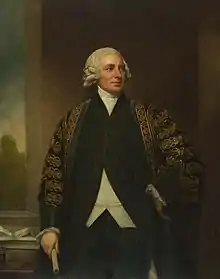
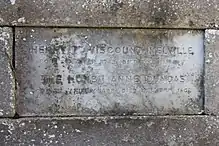

Lord Melville's first marriage was to Elizabeth Rannie, daughter of David Rannie, of Melville Castle, in 1765. She was 15 at the time of the marriage. She committed adultery (then known as "criminal conversation") with a Captain Everard Faukener in 1778, and abandoned Dundas and their four children, fleeing to an undisclosed location. Within days she confessed in a letter to Dundas, saying she was "undeserving of being your wife or the mother to your unhappy children."[46] Approximately a month later they were divorced. She never saw her children again, dying in 1843. Henry Dundas, in accordance with the law of the time, kept their property.[47][48] However, he paid her a monthly annuity until his death, and his son continued the payments until her death at the age of 98.[46]
After this divorce Dundas was married again, to Lady Jane Hope, daughter of John Hope, 2nd Earl of Hopetoun, in 1793. He died in May 1811, in Edinburgh, aged 69, and was succeeded in his titles by his son from his first marriage, Robert. The Viscountess Melville later married Thomas Wallace, 1st Baron Wallace and died in June 1829.[49]
Dundas is buried in a vault in Old Lasswade Kirkyard, with most of his descendants.
Legacy and memory
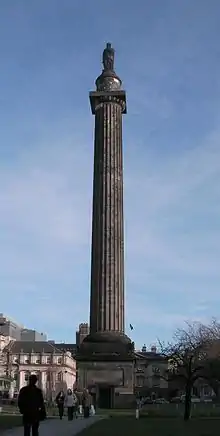
Late in life Dundas was frustrated and financially distressed. He drank heavily. However at his death the immediate reaction was one of widespread praise from most quarters (apart from the whigs in Scotland). By 1900, however, historians were harsh, denouncing him as the epitome of corruption and oppression who had sold out Scotland to the English. By the late 20th century his reputation had been restored. He was praised for his military policies, for giving Scotland a cohesive government and for making it a major player in imperial affairs.[50]
He was friends with John Graves Simcoe, Lieutenant Governor of Upper Canada. Simcoe named the town of Dundas in southern Ontario after him. Owing to the town's short-lived prominence in Upper Canada, streets and historical highways leading to Dundas were named Dundas Street; these include portions of Highway 5, Highway 2 and Highway 8. In 1792 Dundas County was named in his honour. In the city of Toronto, Yonge-Dundas Square is a prominent landmark and commercial centre. Dundas Street is a main thoroughfare of the city. In 2020, over 14,000 people signed an online petition to rename the street in light of Dundas’ actions regarding slavery.[51] In response, Toronto City Council convened to consider further actions to take on all streets and landmarks in the city bearing Dundas’ name.[52][53]
Dundas Island was named by Captain George Vancouver in Dundas' honour. Vancouver originally believed it to be one island, Dundas's Island, but it was later determined that it was in fact a small archipelago. Other islands in the group, known as the Dundas Islands, were given the names Melville Island, Baron Island and Dunira Island in respect of Dundas' titles.[54]
The District of Dundas in New South Wales was named after the Colonial Secretary, Henry Dundas. The District of Dundas was abolished in 1889 although the name still survives in the Sydney suburb of Dundas.[55]
In 1848, John Septimus Roe, the government surveyor (in the then colony of Western Australia), was searching for pastoral land and discovered the area around Norseman which he named Dundas Hills, after the colonial secretary. Gold was discovered there in 1893, the Dundas Field was proclaimed, and the town of Dundas established (ca. 40 km south of Norseman, later abandoned), which eventually led to the present Shire of Dundas.[56]
A monument to Dundas, modeled loosely on Trajan's Column in Rome, stands in the centre of St Andrew Square, Edinburgh. The cost of the Melville Monument was "met by contributions from officers and men of the Royal Navy."[57] It was designed in 1821 by William Burn, who was advised by Robert Stevenson after residents of the square expressed concern about the adequacy of the foundations to support a column of such height. It cost £8,000.[58] The garden surrounding the Melville Monument was opened to the public in 2008.[57] A statue of Dundas, sculpted by Robert Forrest from a model by Francis Chantrey,[59] was added to the top in 1828. The long-time headquarters of the Royal Bank of Scotland, directly to the east, is Dundas House; construction was completed in 1774 for Sir Lawrence Dundas, a relative.[60][61]
A statue (1818), by Sir Francis Chantrey, of Dundas stands against the north wall inside Parliament Hall in Edinburgh. Furthermore, the Melville Monument, an obelisk erected in 1812 on Dunmore hill, overlooking the scenic village of Comrie in Perthshire, commemorates his life.[62]
Dundas Street, Hong Kong, was also named for him.
Controversy over legacy
The Edinburgh statue has proven to be controversial, because of the role Dundas played as Secretary of State for War in allegedly delaying the abolition of the transatlantic slave trade during the 1790s. There were demonstrations against the Dundas statue during the Black Lives Matter protests in 2020.[63]
On 7 June 2020, during a Black Lives Matter protest, the 1st (Henry Dundas) and 2nd (Robert Dundas) Viscount Melville Monuments were graffitied. Demonstrators believed Viscount Melville had caused a 15-year-delay in Parliament voting to abolish the slave trade.[64]
A leading proponent of the movement to reinterpret the Melville monument is Sir Geoff Palmer, a human rights activist and retired science professor at Heriot-Watt University in Edinburgh. He argues that because Viscount Melville proposed an amendment to a Bill before the House of Commons in 1792 to achieve abolition immediately and gradually, and because of his actions later in the 1790s, he delayed abolition of the slave trade by 15 years.[65] However, the compromise 1792 Bill referred to, despite gaining support in the Commons (unlike previous measures in support of abolition), was subsequently defeated in the Lords and so never came into effect. The amendment itself had proposed a transitional period of 7 years and so had the Bill been successful the slave trade would have been abolished sooner than it was.[66]
Fictional references
Lord Melville, as First Lord of the Admiralty, is present or a background character in several of Patrick O'Brian's Aubrey–Maturin novels. As a major official favourably disposed to Jack Aubrey, Lord Melville's political interest is often helpful to the captain. O'Brian casts Melville's impeachment for malversation of public monies as a political attack using naval intelligence spending, the details of which cannot be disclosed for security and the safety of intelligence agents—such as Stephen Maturin. Additionally, Heneage 'Hen' Dundas, a real-life naval officer son of Thomas Dundas, appears as a younger son of Lord Melville. As a former crewmate and close friend of one of the eponymous main characters, Jack Aubrey, Heneage Dundas is one of the recurring characters of the series.
He is also a supporting character in the legal drama Garrow's Law. As a leading figure of the establishment, he is a bitter enemy of the radical hero, William Garrow. He is played by Stephen Boxer. Also, fictional references were made to Sir Henry Dundas in Chapter 24 of L.A. Meyer's third book in the Jacky Faber series, which was titled "Under the Jolly Roger" as well as the former Lord Dundas in Meyer's sixth book, which was titled, "My Bonny Light Horseman". He was portrayed as 'bookish', although a sweet and sincere man otherwise. A reference was made to Henry Dundas and his role in the abolition of the Slave Trade in the motion picture Amazing Grace (2006) where he was played by Bill Paterson.[67]
Dundas is also featured in Joseph Knight, by James Robertson (Fourth Estate, 2003) - a fictional account of the true story of the former slave for whom Dundas successfully appealed to two levels of Scottish courts, ultimately winning a declaration of Knight's emancipation, and the emancipation of all purported slaves on Scottish soil.
Arms
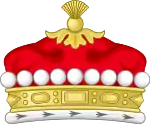  |
|
References
- Dictionary of National Biography, Volumes 1–20, 22
- Fry, Michael (1992). The Dundas Despotism. Edinburgh Univ Pr. pp. 62–65, 141. ISBN 978-0748603527.
- "Henry Dundas' private papers bought for Scots archive". Glasgow: BBC News Scotland. 3 July 2012. Retrieved 7 May 2013.
- "Scotland, Slavery and Statues", BBC Scotland https://www.bbc.co.uk/programmes/m000nrpb#:~:text=Scotland%2C%20Slavery%20and%20Statues%20The%20Melville%20Monument%20in,follows%20the%20debate%20over%20how%20controversial%20politician%20 Retrieved 29 October 2020.
- Lloyd, Karen. "New wording for plaque at Melville Monument agreed". The City of Edinburgh Council. Retrieved 27 January 2021.
- https://www.thetimes.co.uk/article/rewording-of-henry-dundas-plaque-bad-history-says-sir-tom-devine-2bc5f3jw8
- Bator, Paul (1996). "The University of Edinburgh Belles Lettres Society (1759-64) and the Rhetoric of the Novel". Rhetoric Review. 14 (2): 280–298. doi:10.1080/07350199609389066. ISSN 0735-0198. JSTOR 465857.
- "Knight v Wedderburn Upheld". African American Registry. Retrieved 22 June 2020.
- Lovat-Fraser, J.A. (1916). Henry Dundas, Viscount Melville. Cambridge.
- Boswell, James (24 November 2015) [1851]. The Life of Samuel Johnson: Volume III, 1776-1780. ISBN 9783734091261. Retrieved 17 September 2020.
- Caledonian Mercury, 21 Feb. 1776.
- Monteith, Brian (15 June 2020). "Obliterating our history by removing statues is path to repeating mistakes". The Scotsman.
- Michael Fry, The Dundas Despotism, (Edinburgh University Press, 1992), at 200
- Henry Dundas Viscount Melville. p. 63.
- Cobbett, William (Editor) (1817). "The Parliamentary History of England, From the Earliest Period to the Year 1803, Vol XXIX, (First Session of the Seventeenth Parliament; Second Session of the Seventeenth Parliament, 1791-1792), at 359. See also pp 249-359". Bodleian Libraries. Retrieved 2 July 2020.CS1 maint: extra text: authors list (link)
- The Debate on a Motion for the Abolition of the Slave-trade, in the House of Commons, on Monday the Second of April, 1792, Reported in Detail, Great Britain, Parliament, House of Commons, p. 1 https://books.google.ca/books?id=MQJcAAAAQAAJ&pg=PP3#v=onepage&q&f=false
- The Debate on a Motion for the Abolition of the Slave-trade on Monday the 2nd of April 1792, (supra) p. 94-102
- The Debate on a Motion for the Abolition of the Slave-trade, in the House of Commons, on Monday the Second of April, 1792, Reported in Detail, p 169 https://books.google.ca/books?id=5xHejAhwH0oC&dq=%22Debate%20on%20a%20Motion%20for%20the%20Abolition%20of%20the%20Slave-trade%22&pg=PA169#v=onepage&q=%22Debate%20on%20a%20Motion%20for%20the%20Abolition%20of%20the%20Slave-trade%22&f=false
- Cobbett's Parliamentary History - volume 29: Comprising the period from the twenty-second of March 1791, to the thirteenth of December 1792, at p. 1203. Source: Bodleian Libraries, https://digital.bodleian.ox.ac.uk/inquire/p/553bfcda-f828-45c6-8abe-34a19e10011d
- Cobbett's Parliamentary History, Vol 29 (supra) at p. 1268 https://digital.bodleian.ox.ac.uk/inquire/p/51ac0037-8501-495e-abdd-715e4cfda55a
- Cobbett's Parliamentary History, Vol 29 (supra) at p. 1293 https://digital.bodleian.ox.ac.uk/inquire/p/f774affa-febd-4543-b2b2-0912c976e00a
- By way of contrast, see Pennsylvania's 1780 abolition legislation, An Act for the Gradual Abolition of Slavery
- Cobbett's Parliamentary History, (supra) at p. 1293 https://digital.bodleian.ox.ac.uk/inquire/p/f774affa-febd-4543-b2b2-0912c976e00a
- Farrell, Stephen (2007). "'Contrary to the Principles of Justice, Humanity and Sound Policy': The Slave Trade, Parliamentary Politics and the Abolition Act, 1807". Project MUSE. Parliamentary History, vol. 26 no. 4, 2007, p. 141-202. Retrieved 2 July 2020.
- Wilberforce, Robert Isaac (1843). The Life of Wilberforce. London: Seeley, Burnside and Seeley. pp. 327–328.
- Furber, Holden, Henry Dundas: first viscount Melville, 1741-1811, political manager of Scotland, statesman, administrator of British India. London: Oxford University Press, H. Milford (1931) at p. 302
- David Brion Davis, The Problem of Slavery in the Age of Revolution, 1770-1823 (Oxford: 1999) https://books.google.ca/books?id=xkAm6BKNU9MC&pg=PT112&dq=Henry+Dundas+obstructed+end+slavery&hl=en&sa=X&ved=2ahUKEwjBsIrbnfHrAhWJPM0KHcQbB2MQ6AEwAnoECAIQAg#v=onepage&q=Henry%20Dundas%20obstructed%20end%20slavery&f=false Retrieved 29 October 2020.
- Blackburn, Robin. (1988). The overthrow of colonial slavery, 1776-1848. London: Verso. ISBN 0-86091-188-8. OCLC 17384058.
- Anstey, Roger. (1975). The Atlantic slave trade and British abolition, 1760-1810. London: Macmillan. ISBN 0-333-14846-0. OCLC 1404090.
- Stephen Tomkins, The Clapham Sect: How Wilberforce's Circle Transformed Britain (Oxford:2010) p. 99. https://books.google.ca/books?id=3PXNBAAAQBAJ&pg=PA99&dq=Henry+Dundas+obstructed+end+slavery&hl=en&sa=X&ved=2ahUKEwi11YHjoPHrAhXIXM0KHXpDCRkQ6AEwAHoECAYQAg#v=onepage&q=Henry%20Dundas%20obstructed%20end%20slavery&f=false Retrieved 29 October 2020.
- Peter J. Kitson, Debbie Lee and Anne K. Mellor, Slavery, Abolition and Emancipation, Vol. 2 https://books.google.ca/books?id=sS_gDwAAQBAJ&pg=PT23&dq=Henry+Dundas+GRADUAL+slavery&hl=en&sa=X&ved=2ahUKEwiklu-crPHrAhXiUd8KHUs5D8wQ6AEwA3oECAUQAg#v=onepage&q=Henry%20Dundas%20GRADUAL%20slavery&f=false Retrieved 29 October 2020.
- https://www.thetimes.co.uk/article/rewording-of-henry-dundas-plaque-bad-history-says-sir-tom-devine-2bc5f3jw8
- "BBC News for Scotland Edinburgh-East-Fife". The BBC. 14 June 2020. Retrieved 22 June 2020.
- Lloyd, Karen. "New wording for plaque at Melville Monument agreed". The City of Edinburgh Council. Retrieved 27 January 2021.
- David Geggus, Slavery, War and Revolution: The British Occupation of Saint Domingue, 1793-1798 (New York: Clarendon Press, 1982).
- C.L.R. James, Black Jacobins (London: Penguin, 1938), pp. 109, 163-182.
- Campbell, Maroons of Jamaica, pp. 209–49.
- "Henry Dundas, empire and genocide". openDemocracy. Retrieved 27 January 2021.
- Edward B. Jones, "Henry Dundas, India, and British Reactions to Napoleon's Invasion of Egypt, 1798-1801" Proceedings of the South Carolina Historical Association (1973), pp 41-57.
- Hague, William (2004). William Pitt the Younger. Harper Collins.
- E.H. Coleridge, The Life of Thomas Coutts, Banker, at p. 213. https://archive.org/details/cu31924088024314
- The Life of Thomas Coutts, Banker, (supra) at 213
- Gary D. Hutchison, "‘The Manager in Distress’: Reaction to the Impeachment of Henry Dundas, 1805–7." Parliamentary History 36.2 (2017): 198-217. https://onlinelibrary.wiley.com/doi/abs/10.1111/1750-0206.12295
- "No. 16014". The London Gazette. 28 March 1807. p. 393.
- Historical Dictionary of the Napoleonic Era, (supra) at p. 190
- Leneman, Leah (1998). Alienated Affections - The Scottish Experience of Divorce and Separation, 1684-1830. Edinburgh: Edinburgh University Press. p. 52. ISBN 0 7486 1031 6.
- BBC Radio Scotland, Disposable Brides, episode 2, 6 April 2011
- Hamish MacPherson, "Henry Dundas: The Scotsman who kept slavery going", The National 10 June 2020 https://www.thenational.scot/news/18506771.henry-dundas-scotsman-kept-slavery-going/ Retrieved 20 June 2020.
- Fry, Michael. "Dundas, Henry, first Viscount Melville (1742–1811)". Oxford Dictionary of National Biography (online ed.). Oxford University Press. doi:10.1093/ref:odnb/8250. (Subscription or UK public library membership required.)
- Fry, 2004.
- "Hundreds sign petition demanding Toronto rename major street due to racism concerns". Toronto. 10 June 2020. Retrieved 27 January 2021.
- "Toronto council agrees to spend $250,000 to consult on renaming Dundas Street". thestar.com. 1 October 2020. Retrieved 27 January 2021.
- "Recognition Review". City of Toronto. 21 July 2020. Retrieved 27 January 2021.
- "Dundas Island". BC Geographical Names. The Province of British Columbia. Retrieved 15 July 2015.
- Patrick, Trevor. "Castle Hill Coffee". Sydney, Australia: Hillstory. Retrieved 15 July 2015.
- "Norseman". Dundas, Western Australia: Goldfields Key. Retrieved 15 July 2015.
- "Melville Monument". The Gazetteer for Scotland. Retrieved 15 July 2015.
- Scadding, Henry (January 1878). "Yonge Street and Dundas Street: The Men after whom they were named". The Canadian Journal of Science, Literature and History. 15 (8): 640. Retrieved 6 May 2013.
- Historic Environment Scotland. "St Andrew Square, Melville Monument... (Category A Listed Building) (LB27816)". Retrieved 27 March 2019.
- McWilliam, Colin; Walker, David; Gifford, John (1984). Buildings of Scotland: Edinburgh (Revised ed.). Pevsner Architectural Guides. ISBN 978-0140710687.
- Ferguson, Brian (6 May 2012). "RBS plan to share historic Edinburgh HQ". The Scotsman. Retrieved 15 July 2015.
- Gifford, John (2007). Perth and Kinross. Yale University Press. p. 61.
- "Scotland, Slavery and Statues", BBC Scotland https://www.bbc.co.uk/programmes/m000nrpb#:~:text=Scotland%2C%20Slavery%20and%20Statues%20The%20Melville%20Monument%20in,follows%20the%20debate%20over%20how%20controversial%20politician%20 Retrieved 29 October 2020.
- BBC News (8 June 2020). "George Floyd protests: The statues being defaced". BBC. Retrieved 6 July 2020.
- Euro News (11 June 2020). "Sir Geoff Palmer: 'Don't take down statues – take down racism'".
- Fry, Michael, 1947- (1992). The Dundas despotism. Edinburgh: Edinburgh University Press. ISBN 0-7486-0352-2. OCLC 30892247.CS1 maint: multiple names: authors list (link)
- Amazing Grace at IMDb
- Burke's Peerage. 1878.
 This article incorporates text from a publication now in the public domain: Chisholm, Hugh, ed. (1911). "Melville, Henry Dundas, 1st Viscount". Encyclopædia Britannica (11th ed.). Cambridge University Press.
This article incorporates text from a publication now in the public domain: Chisholm, Hugh, ed. (1911). "Melville, Henry Dundas, 1st Viscount". Encyclopædia Britannica (11th ed.). Cambridge University Press.
Further reading
- Brown, David. "The Government of Scotland under Henry Dundas and William Pitt." History 83.270 (1998): 265–279.
- Dwyer, John, and Alexander Murdoch. "Paradigms and Politics: Manners, Morals and the Rise of Henry Dundas, 1770-1784," in John Dwyer, Roger A. Mason, and Alexander Murdoch (eds.), New Perspectives on the Politics and Culture of Early modern Scotland (Edinburgh: John Donald Publishers, 1982), pp. 210–248.
- Ehrman, John. The Younger Pitt: The Years of Acclaim (1969); The Reluctant Transition (1983); The Consuming Struggle (1996). Monumental scholarly study with extensive coverage of Dundas.
- Fry, Michael. "Dundas, Henry, first Viscount Melville (1742–1811)" Oxford Dictionary of National Biography (2004) https://doi-org.wikipedialibrary.idm.oclc.org/10.1093/ref:odnb/8250 online
- Fry, Michael. The Dundas despotism (1992) on Scotland
- Furber, Holden. Henry Dundas: First Viscount Melville, 1741–1811, Political Manager of Scotland, Statesman, Administrator of British India (Oxford UP, 1931). Long scholarly biography online
- Hutchison, Gary D. "‘The Manager in Distress’: Reaction to the Impeachment of Henry Dundas, 1805–7." Parliamentary History 36.2 (2017): 198-217. online
- Ingram, Edward. Two Views of British India: Private Correspondence of Mr. Dundas and Lord Wellesley, 1798-1801 (Adams & Dart, 1970)
- Matheson, Cyril. The Life of Henry Dundas, First Viscount Melville, 1742–1811 (1933).
- Wright, Esmond. "Henry Dudas--Harry the Ninth." History Today (March 1958) 8#3 pp 155–163
External links
- Finding aid to the Henry Dundas papers at the University of Pennsylvania Libraries
- Hansard 1803–2005: contributions in Parliament by the Viscount Melville
- Letters and memoranda (1792-1812) of Henry Dundas, Viscount Melville and Robert Dundas, Viscount Melville (1771-1851) are held by SOAS Archives.
.svg.png.webp)